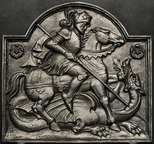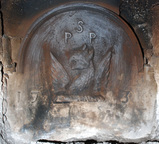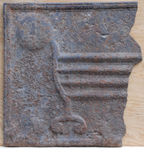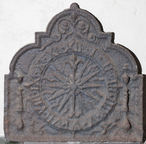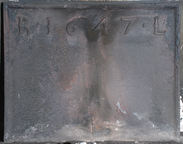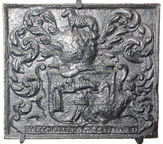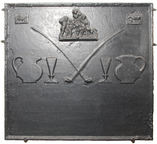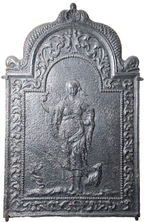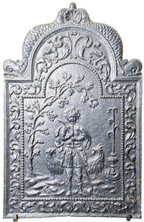-
1211
Description: Arched rectangular shape: ovolo-moulded edging; pictorial scene of St George in armour, mounted on a horse, spearing a dragon which lies beneath the horse; in each top corner, a rose.
Notes: A portrayal of St George and the Dragon in bold relief that owes something to the famous modelling by Benedetto Pistrucci of 1817; however, the figure of St George is disproportionately large in relation to the horse.
- Decoration tags:
- rectangular with round arch (shape)
- ovolo (edging)
- whole carved pattern
- pictorial
- mythological
- animals
- humans
- plants
Manufactured: in the 20th century in England.
Current location: Thornhill Galleries, 43-45 Wellington Crescent, New Malden, London, England.
- Attached to series:
- Miscellaneous pattern firebacks
-
501
Description: Arched rectangular shape; ovolo-moulded edging; central crest of a gryphon's head couped, its wings displayed; above, the initials, the 'S' above the 'P's; below, the date.
Notes: The crest is likely to be that of Peter Short of Lindfield, Sussex, who married Philadelphia Burrell in 1704.
Inscription: PSP / 1730
Arms: Short of Lindfield
- Decoration tags:
- rectangular with round arch (shape)
- ovolo (edging)
- carved stamps
- individual letters
- individual numbers
- heraldic
- text
Manufactured: in 1730 possibly in the Weald area of England.
Current location: in private hands, Newick, East Sussex, England.
- Attached to series:
- Personal firebacks
- Date & initials firebacks
- 1730s-40s, date & initial series
-
1086
Description: Fragment; rectangular shape; ovolo-moulded edging; image of an iron grate with barred front and integral andiron with iron or brass disc.
Notes: A unique example; it is not certain how the mould was formed, whether by impressing an actual grate or carving a pattern with the image of a grate; the former seems more likely.
- Decoration tags:
- rectangular (shape)
- ovolo (edging)
- simple stamps
- objects
Manufactured: in the mid- to late-17th century possibly in the Weald area of England.
Current location: in private hands, Outwood, Surrey, England.
- Attached to series:
- Miscellaneous pattern firebacks
- Metalware stamp firebacks
-
512
Description: Double arched rectangular shaped; ovolo edging; central clock dial with Roman numerals separated by stops, sunburst inside, single hand with fleur de lys pointer; teardrop weights, with finials above, suspended from each side; symmetrical tendrils above; date split below dial.
Notes: One of the ‘hooked 1’ series of firebacks; two versions exist of this fireback, the other without finials above the suspended weights.
Copies of this fireback are known.
Inscription: I · II · III · IIII · V · VI · VII · VIII · IX · X · XI · XII / 16 5 [..]
- Decoration tags:
- rectangular with round arch (shape)
- ovolo (edging)
- whole carved pattern
- pictorial
- text
- objects
Manufactured: in 1652 possibly at Brede Furnace in the Weald area of England.
Current location: Penshurst Place, Penshurst, Kent, England.
Citation: Gardner, J. S., 1898, 'Iron Casting in the Weald', Archaeologia, 56, 1, pp. 133-164.
- Attached to series:
- Hooked '1' series
- Brede group
-
514
Description: Rectangular; ovolo-moulded edging (top and sides); inscription along top of plate.
Notes: The initials may relate to Robert, 2nd Earl of Leicester.
Inscription: R · 1647 · L
- Decoration tags:
- rectangular (shape)
- ovolo (edging)
- individual letters
- individual numbers
- text
Manufactured: in 1647 in the Weald area of England.
Current location: Penshurst Place, Penshurst, Kent, England.
- Attached to series:
- Date & initials firebacks
-
546
Description: Rectangular; ovolo edging; shield, helm, crest, mantling and motto of the Merchant Taylors’ Company: Argent a Pavilion Imperial Purple garnished Or lined Ermine between two Mantles also Imperial Purple lined Ermine on a chief Azure a Lion passant guardant Or.
Notes: Arms were re-granted to the Company in 1586; the excrescences on the helm and shield are probably the result of splashes caused when pouring the iron into the mould from too great a height. Mitford collection, Petworth House.
Inscription: CONCORDIA PARVAE RES CRESCUNT [In Harmony Small Things Grow]
Arms: Worshipful Company of Merchant Taylors
- Decoration tags:
- rectangular (shape)
- ovolo (edging)
- whole carved pattern
- armorial
- text
Manufactured: in the late-16th to early-17th century possibly in the Weald area of England.
Current location: Petworth House, Petworth, West Sussex, England.
Museum number: NT/PET/M/101 (part of the National Trust museum group)
- Attached to series:
- Livery company firebacks
-
551
Description: Rectangular; ovolo-moulded edging; top centre, stamp formed of a carved domestic scene of a family around a table, between two small mirrored rectangular stamps each of a cow; lower centre, symmetrical arrangement of two jugs, two goblets and two crossed churchwarden pipes, all in low relief.
Notes: The domestic group has been formed from a decorative iron mantelpiece ornament portraying the tale of the goose that laid golden eggs. Having killed the goose, the family are lamenting the loss of their bounty (see Ames, 1980, p.94). The style of the fireback suggests a pastiche using designs suggesting the past. The same mantelpiece group can be seen as decoration on the kitchen spit assemblage at Petworth House, West Sussex, which was cast at Robert Chorley's foundry at Cocking, south of Midhurst. Evidently this and another fireback bearing the same ornament stamp were among items from the Cowdray estate sold in 1898. Mitford collection, Petworth House.
- Decoration tags:
- rectangular (shape)
- ovolo (edging)
- carved stamps
- animals
- humans
- objects
Manufactured: in the early-19th century probably at Cocking Foundry in the Weald area of England.
Current location: Petworth House, Petworth, West Sussex, England.
Museum number: NT/PET/M/43 (part of the National Trust museum group)
Citation: Ames, A., 1980, Collecting Cast Iron (Ashbourne, Moorland Publishing).
- Attached to series:
- Cocking foundry firebacks
- Ornament stamp firebacks
- Metalware stamp firebacks
-
553
Description: Arched rectangular shape; bead-on-fillet edging; standing figure of a female holding a torch in her right hand, a goat by her feet, and a bush bottom left; arched rectangular border with ovolo-moulded edging; symmetrical arrangement of scrolled foliage; on top, a scallop shell with a descending dolphin on each side of the arch.
Notes: The figure is an allegorical representation of Wisdom. Mitford collection, Petworth House.
- Decoration tags:
- 'Dutch' (shape)
- ovolo (edging)
- whole carved pattern
- pictorial
- allegorical
- humans
Manufactured: in the mid- to late-17th century possibly in the Siegerland area of Germany.
Current location: Petworth House, Petworth, West Sussex, England.
Museum number: NT/PET/M/45 (part of the National Trust museum group)
- Attached to series:
- 'Dutch' tall arch series
-
568
Description: Arched rectangular shape; bead-on-fillet edging; in a garden of ground, a tree and a tall plant in a pot, the standing figure of a young person blowing a pipe, two sheep or goats behind; arched rectangular border with ovolo-moulded edging; symmetrical arrangement of scrolled foliage; on top, a scallop shell with a descending dolphin on each side of the arch.
Notes: The scene may be allegorical or purely representational. Mitford collection, Petworth House.
- Decoration tags:
- 'Dutch' (shape)
- ovolo (edging)
- whole carved pattern
- pictorial
- allegorical
- animals
- humans
- plants
Manufactured: in the mid- to late-17th century possibly in the Siegerland area of Germany.
Current location: Petworth House, Petworth, West Sussex, England.
Museum number: NT/PET/M/60 (part of the National Trust museum group)
- Attached to series:
- 'Dutch' tall arch series
-
582
Description: Arched shape with ovolo-moulded edging; figure of a classical warrior with plumed helmet and shield, holding a sword in his right hand; inscription to left of head, probably continued to right by now no longer visible.
Notes: An unusually striking fireback of simple design. Mitford collection, Petworth House.
Inscription: ANNO ...
- Decoration tags:
- rounded arched (shape)
- ovolo (edging)
- whole carved pattern
- pictorial
- mythological
- text
- humans
Manufactured: in the mid- to late-17th century possibly in the Lorraine area of Germany.
Current location: Petworth House, Petworth, West Sussex, England.
Museum number: NT/PET/M/73 (part of the National Trust museum group)
- Attached to series:
- Miscellaneous pattern firebacks
- 'Dutch' Miscellaneous Firebacks
